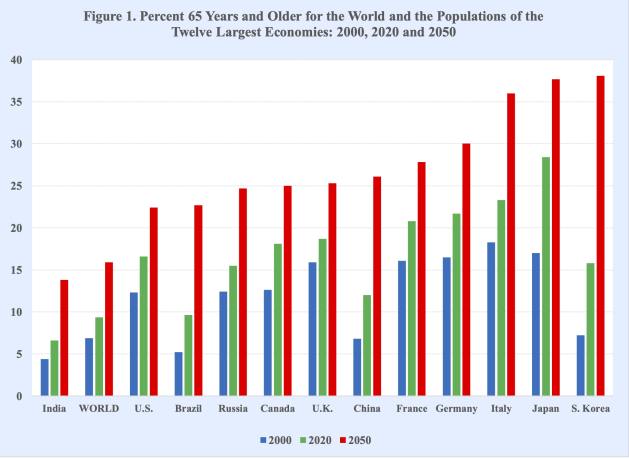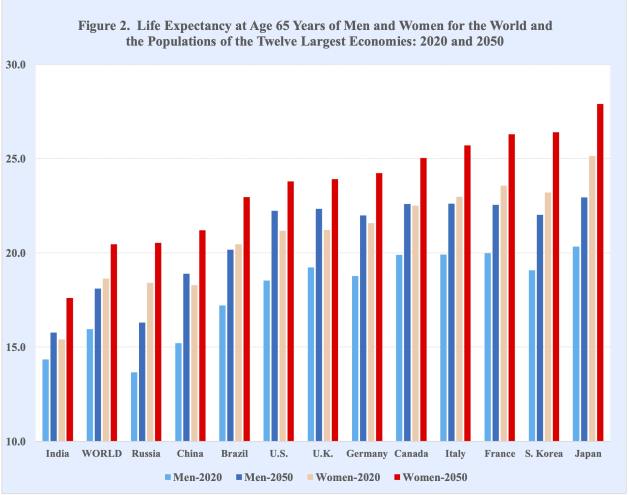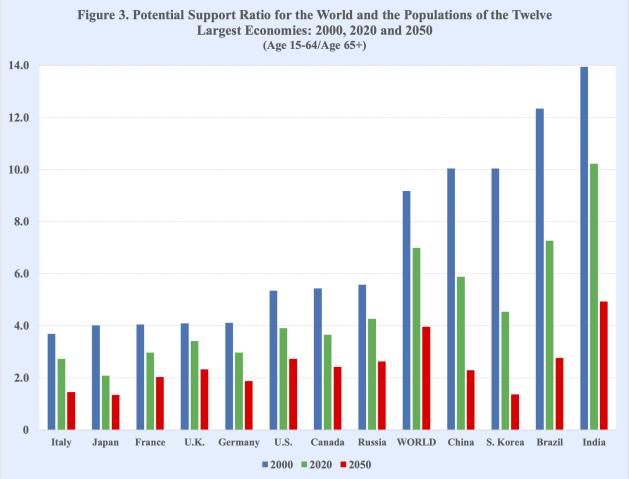Caring for the old
With the unprecedented ageing of populations worldwide, countries are struggling with the critical questions of who should be responsible for caring for the old and what should be the extent of care provided to women and men in old age.
Many believe that the government should be responsible for covering the costs and providing care, support and assistance to the old. In contrast, others, in particular social conservatives, contend that families and the old themselves should be responsible for providing the needed care, support and assistance for the old.
Similarly with respect to the extent of care to be provided to the old, some argue that given the high costs, the demands involved and the appropriate role of government in family life, only rudimentary care should be made available to the old in need. Others, however, believe that government should provide a broad array of services and care to the old, especially for those with special needs and disabilities.
For many countries the issue of caring for the old is the single most expensive domestic priority today and is expected to remain so in the years ahead. In addition to the substantial financial costs, governments are wrestling with contentious policy issues, including competing national priorities, the proper role of government and the responsibilities of individuals for their personal wellbeing in old age.
The significant increases in the proportions elderly that occurred during the past two decades are expected to continue throughout the 21st century. Among the populations of the twelve largest economies, for example, which account for approximately 70 percent of the world economy and 50 percent of the world’s population, the proportions 65 years and older have increased markedly since the start of the 21st century (Figure 1).
In China, for example, the proportion aged 65 years and older nearly doubled in the recent past, increasing from less than 7 percent in 2000 to 12 percent in 2020. That proportion is expected to more than double by 2050, reaching 26 percent. Similarly, South Korea’s proportion elderly jumped from 7 percent in 2000 to 16 percent in 2020 and is expected to reach nearly 40 percent by 2050, with Japan and Italy close behind at approximately 38 percent elderly.
In addition to the growing proportions of the old, men and women are living longer than ever before. Since World War II remarkable achievements have been made in reducing mortality rates and increasing the length of human lives worldwide.
Over the past seven decades the world’s average life expectancy at birth has increased 26 years, from 47 to 73 years. The gains in life expectancy at birth over that period have been even greater, exceeding 33 years, in many developing countries, including Bangladesh, China, Ethiopia, India, Iran, Oman, Peru, Saudi Arabia, South Korea and Turkey.
The reductions in mortality rates are also providing additional years of life for the old. For example, by midcentury average life expectancies at age 65 among most of the populations of the twelve largest economies are expected to be no less than 20 years for men and no less 23 years for women (Figure 2).
Particularly noteworthy are the projected life expectancies of elderly women in France, Italy, Japan and South Korea in 2050. In those countries, women on average can expect to live well into their nineties by midcentury.
Human longevity is also reaching record levels. The numbers reaching age 100 years, for example, have grown markedly over the recent past. Worldwide the number of centenarians increased nearly four-fold since the start of the 21st century and is expected to increase nearly eight-fold by midcentury, reaching close to 5 million.
Among the populations of the twelve largest economies, the numbers of centenarians are projected to more than quadruple by 2050. The numbers of centenarians in Brazil and China, for example, are expected to increase eight-fold over the coming three decades.
Also importantly, the ageing of populations is also resulting in a declining ratio of tax-paying workers to retirees. The potential support ratio (PSR), or the ratio of working-age persons aged 15 to 64 per one person aged 65 years and older, is declining rapidly with important consequences for decision-making, resource allocations and societal wellbeing.
At the global level, the PSR declined from 9 persons in the working-ages per person aged 65 years and older at the start of the century to 7 in 2020 and is projected to decline further to 4 by midcentury. Also, by the year 2050 some countries, including China, France, Germany, Italy, Japan, South Korea and the United Kingdom, are expected to have PSRs of approximately 2 persons or less in the working-ages for each person aged 65 and older (Figure 3).
Due to demographic pressures of growing elderly populations and the relative decline of workers paying taxes, governments are increasingly facing the need to adjust budgetary expenditures. Some political leaders advocate less spending on domestic programs and entitlements for the old and shifting more of the costs for support, caregiving and services to the old and their families, which they maintain has been successfully practiced by societies throughout much of the past.
Others, however, call for a readjustment of government expenditures including less spending on costly programs, including defense, and increased spending on the rising demands for services, support and care for the old. Increasing taxes on the wealthy, they argue, could make additional funding available for caring for the old.
Encountering increasing difficulties caring for the old, some governments, including China, India and the United States, have promoted and legislated filial obligations for elderly parents. In China, for example, Article 47 of the constitution states that adult children have the duty to support and assist their parents. Also, China passed a law nearly a decade ago requiring people to visit or keep in touch with their elderly parents or risk being sued.
Also in India, the government passed the Maintenance and Welfare of Parents and Senior Citizens Act in 2007, permitting needy elderly parents to seek monthly maintenance assistance from their children. In the United States, requiring children to care and provide support for their elderly parents is a state-by-state issue, with approximately half the states having filial responsibility laws.
The 21st century is one of unprecedented population aging. The increasing numbers and proportions of the old, who are living longer than ever before, are occurring with simultaneous declines in tax-paying workers who finance programs for the old in many countries.
The ageing of populations is challenging the viability of government pension systems and healthcare programs for the old. In addition, the demographic changes are increasing stress, anxiety and burdens on families, many of whom are struggling to find the resources, time and means to care for elderly family members.
Caring for the old can be particularly burdensome for women, who have traditionally provided care and assistance to elderly family members yet received limited compensation or recognition for their efforts. While many find providing care to the old emotionally rewarding, the work can be burdensome, interrupt employment and careers and harm the economic and personal well-being of caregivers.
In sum, caring for the old will increasingly be a mounting challenge for governments, communities and families throughout the 21st century. Among the central aspects of that challenge are who should be responsible for providing care for the old and what should be the nature and extent of the care to be provided to the old.
Ignoring or postponing addressing the consequences of population ageing is the typical response of governments when confronting relatively slow-moving, momentous demographic trends. Doing so, however, will only intensify the formidable challenge of caring for the old.

Popular Posts
-
Religion is a part of the spiritual life in society, this phenomenon of the superstructure has been strongly changed with economic - social...
-
Vietnam has just done well for the second cycle of Universal Periodical Review (UPR) in Geneva, Switzerland. So, what’s the UPR? an...
-
Representatives from foreign countries congratulate Viet Nam on its election to the Human Rights Council for the first time on November ...
-
A street flowers vendor in Hanoi Another new spring has come to Vietnam, bring...
-
Thai people in Shutdown Bangkok protests Not until this crisis, we have realized the ne...
-
If nothing changes, there will be a preferential credit program with hundreds of thousands billion of capital for agriculture and r...
-
Recently, several anti-governmental individuals have established series of illegal groups and organizations in the name of civil soci...
-
Child sexual abuse has been on the increase in Vietnam in recent years according to the Ministry of Labour, Invalids and Social Affairs....
Blog Archive
-
▼
2022
(
418
)
-
▼
tháng 2
(
46
)
- Applying Ho Chi Minh’s ideology to the Party build...
- Continuing renewing the Party’s method of leadersh...
- Diplomatic achievements show Party and State’s cle...
- UNDP approves 2022-2026 Country Programme for Việt...
- Vietnamese solidarity has never shone so brightly
- Vietnamese women’s desire to rise promoted in new era
- ‘Whole Life Cycle of Plastics’ Approach Could Redu...
- Vietnam successfully affirms its position on inter...
- Vietnam welcomes nearly 9,000 international touris...
- Importance of protecting Party’s ideological found...
- Viet Nam exhibits amazing commitment, solidarity t...
- Promoting Vietnamese culture essential for interna...
- Vietnam seeks to integrate women, peace, security ...
- Party leader’s book on Vietnam’s path to socialism...
- Nobel Prizes and Donation Pledges
- Vietnam strengthens ties with neighbours to raise ...
- Achievements in overseas Vietnamese affairs in 202...
- More efforts invested in poverty reduction in ethn...
- Vietnam new Asian tiger: Business Times
- Land law and policies should ensure harmonious int...
- Waking Up After A Long Hibernation
- Optimistic signs of “green” FDI inflow
- Vietnam eyes to be responsible, sustainable food s...
- Vietnam shares experience in poverty reduction, cr...
- Forecasting the World Order in the Post-Covid-19 Era
- Việt Nam considers setting up renewable energy cen...
- VN to build a modern and sustainable agriculture e...
- Young take great pride in military service
- Vietnam’s economy to strongly rebound in 2022
- Fighting against one-sided and misleading viewpoin...
- Military doctors take care of ethnic people's health
- Vietnam’s 'vaccine passport' recognised by 14 coun...
- Standard Chartered: VN's economy to grow at 6.7 pe...
- Việt Nam ready to welcome back tourists
- Measures to be taken to protect legitimate rights ...
- Foreign scholars highlight values of President Ho ...
- Art performance honours frontline forces in COVID-...
- Việt Nam calls for restraint in Ukraine-Russia con...
- Việt Nam fosters cooperation with FBI in crime pre...
- Cyber-attacks in Vietnam decline in 2021
- Caring for the old
- United States’ pivot towards Asia-Pacific Region –...
- War Clouds in Europe: Alert and Alarm in Asia
- Dialogue seeks ways to help women in climate-resil...
- Contributions by health workers always memorised, ...
- PM issues dispatch on protecting Vietnamese citize...
-
▼
tháng 2
(
46
)

 Viet Nam Human Rights
Viet Nam Human Rights











All comments [ 20 ]
Caring for the elderly can be challenging — particularly if a loved one doesn't want help.
Understand what's causing your loved one's resistance and how you can encourage cooperation.
If your loved one is in need of care, he or she is likely dealing with loss — physical loss, mental loss, the loss of a spouse or the loss of independence. Accepting help might mean relinquishing privacy and adjusting to new routines.
Make an honest assessment of what kind of help your loved one needs and which services might work best.
Choose a time when you and your loved one are relaxed. This will make it easier for you and your loved one to listen to each other and speak your minds.
It's important to take them into consideration. If your loved one has trouble understanding you, simplify your explanations and the decisions you expect him or her to make.
Family and friends might be able to help you persuade your loved one to accept help.
If your loved one continues to resist care and is endangering himself or herself, enlist the help of a professional. Your loved one might be more willing to listen to the advice of a doctor, lawyer or care manager about the importance of receiving care.
Resistance to care is a challenge that many caregivers face. By keeping your loved one involved in decisions about his or her care and explaining the benefits of assistance, you might be able to help your loved one feel more comfortable about accepting help.
The creeping prevalence of aging societies isn’t just a challenge for national governments, policymakers, and healthcare providers to solve.
Remaining in good health as an older adult requires much more than what medication and treatment alone have to offer.
Try to find care providers who are willing to provide care for your loved one outside a hospital setting and in the home. For some care providers this may mean home visits, for others it could mean telehealth appointments.
Encourage your loved one to make their own decisions about the type of care they receive and when and where they would like to receive it.
Create opportunities for your loved one to play an active role in your family and in your community. Isolation can be a major cause of emotional distress for older people.
Keep abreast of new technologies that can improve every aspect of care your loved one receives.
Recognize the challenges inherent in caring for a loved one in need and make use of any resources available to you in these efforts.
Older adults experience unique social, physical and economic challenges that other segments of the population may not.
The coronavirus pandemic also underscored the importance of strengthening the systems that support older adults who are more susceptible to severe illness or death.
Given these unique challenges, lawmakers may consider a variety of comprehensive approaches that span a number of policy areas supporting older adults’ social, physical and economic wellbeing.
Given the multiple challenges older adults face during the pandemic, such as increased health risks and social isolation, states are considering integrated approaches to address these challenges.
Your comments